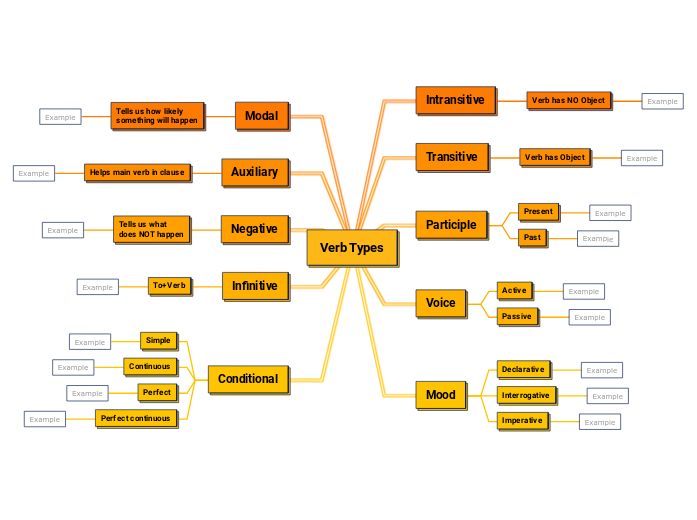{createBy}
{mapViews}
Verb Types
Use this mind map to improve your understanding of how verbs are used in different tenses and practice by creating different contexts.
Keywords: grammar, language

{createBy}
{mapViews}

Mer av detta
As the main word in a sentence, the verb will generally describe an occurrence or an action.
Conditional verbs are used to create conditional sentences, which express hypothetical or unlikely situations. Conditional verbs can be used in the past, present, or future tense, and auxiliary verbs like can/could, will/would, and may/might are important in forming conditionals
An infinitive verb is essentially the base form of a verb with the word 'to' in front of it. When you use an infinitive verb, the 'to' is a part of the verb. It is not acting as a preposition in this case.
The negative verb forms are made by putting not after an auxiliary verb.
Auxiliary verbs are verbs such as have, be, may, do, shall, will, can, or must that are used with another verb to show the verb's tense, to form a question, etc.
A modal verb is a type of verb that is used to indicate modality. Commonly used modal verbs are can, could, must, should, had better, have to and sometimes need or dare.
Grammatical mood refers to the quality or form of a verb in a sentence. More specifically, mood denotes the tone of a verb in a sentence, so the intention of the writer or speaker is clear.
In grammar, the voice of a verb describes the relationship between the action that the verb expresses and the participants identified by its arguments.
A participle is a form of a verb that can be used as an adjective or combined with the verb to be to construct different verb tenses.
A transitive verb will only makes sense if it applies its action on an object.
An intransitive verb has two characteristics:
1.it is an action verb, expressing a doable activity
2.it will not have a direct object receiving the action
Create sentences with examples!
Tankekartor hjälper dig att brainstorma, skapa relationer mellan begrepp, organisera och generera idéer.
Mallar för mind maps är dock ett enklare sätt att komma igång, eftersom de är ramverk som innehåller information om ett specifikt ämne med vägledande instruktioner. I grund och botten är mind map-mallar en struktur som kombinerar alla element i ett specifikt ämne och fungerar som en utgångspunkt för din personliga mind map. De är en resurs som ger en praktisk lösning för att skapa en mind map om ett visst ämne, antingen för företag eller utbildning.
Mindomo ger dig smarta mind map-mallar som gör att du kan fungera och tänka utan ansträngning.
Beskrivande ämnen
Ämnen med bakgrundstext
Standardgren
Ta bort malldata
Du kan välja mellan en mängd olika mind map-mallar från Mindomos konton för företag eller utbildning, eller så kan du skapa dina egna mind map-mallar från grunden. Varje mind map kan omvandlas till en mind map-mall genom att lägga till ytterligare vägledande kommentarer till ett av dess ämnen.